
December 9 2023
8 min read

Jul
Telemedicine implementation can seem complex, but its undeniable benefits for patients and healthcare providers make it a crucial aspect of modern healthcare. With the growing demand for remote healthcare solutions, telemedicine has become more essential than ever. However, many healthcare organizations and practitioners may feel overwhelmed and uncertain about where to begin.
To ease your journey into telemedicine, we have developed a simple step-by-step roadmap. Whether you’re a small clinic or a large hospital, our guidance will help you navigate the world of telemedicine and ensure a smooth and successful transition.
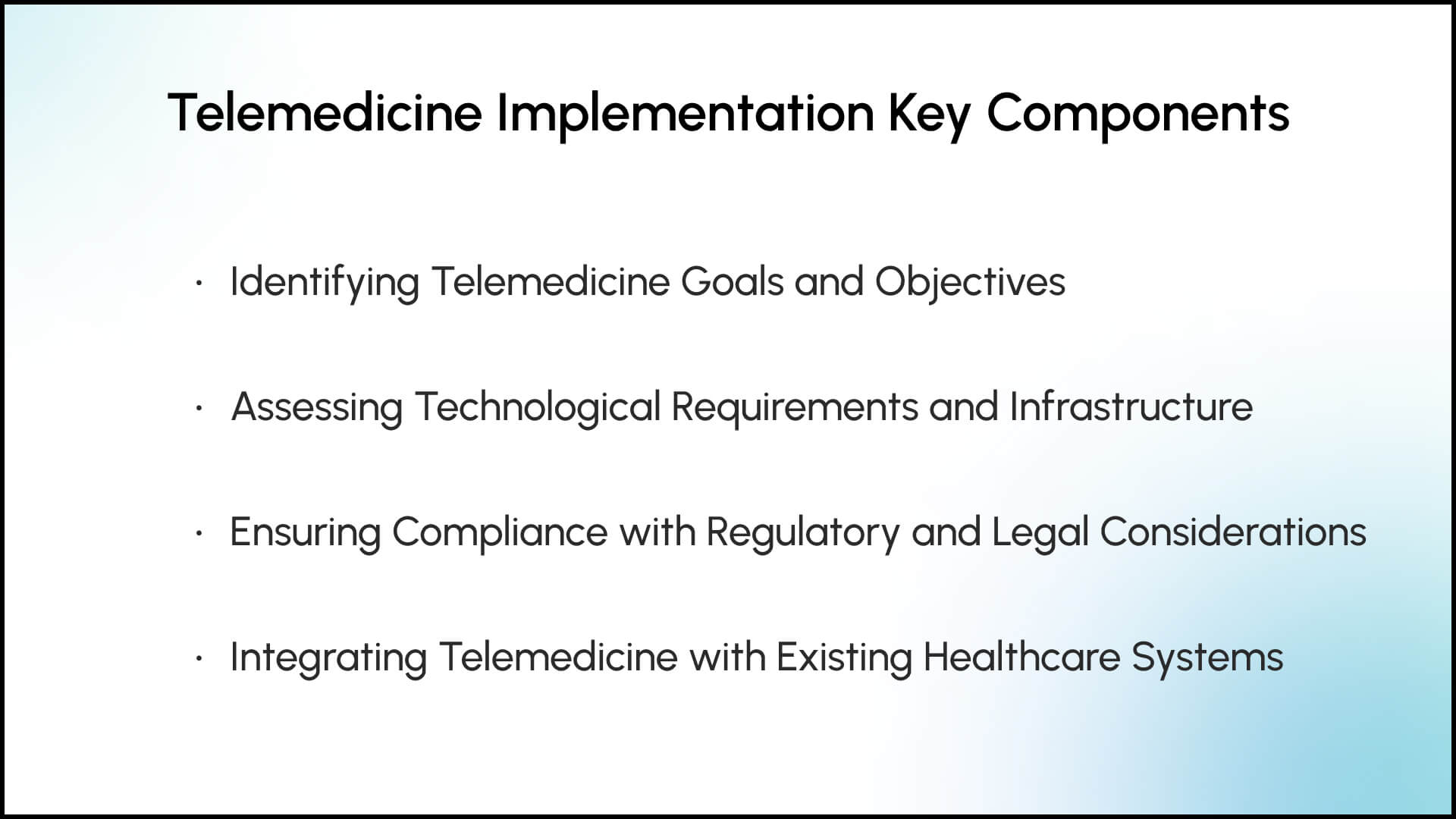
With the healthcare industry wholeheartedly embracing telemedicine, it’s essential for healthcare organizations to grasp the key components of a successful implementation.
Why? Well, because they pave the way for efficient and effective virtual care! So, let’s dive right in and explore the essential elements that make up a well-executed telemedicine strategy!
Before diving into telemedicine implementation, healthcare providers must clearly define their goals and objectives. Identifying specific aims will not only guide the implementation process but also help in measuring the success of the telemedicine program.
Expanded Access to Care: One of the primary goals of telemedicine may be to extend medical services to patients in remote or underserved areas, ensuring that quality healthcare is accessible to all.
Improved Patient Outcomes: Telemedicine can target specific medical conditions, aiming to enhance patient outcomes and reduce hospital readmissions.
Enhanced Care Coordination: Streamlining communication between healthcare providers and specialists can improve care coordination, especially for patients with complex medical needs.
Cost Savings and Efficiency: Telemedicine can be used strategically to optimize healthcare resources and reduce overall healthcare costs.
Number of Virtual Consultations: Determine the expected volume of telemedicine consultations, both in terms of patients and specialty areas.
Patient Satisfaction: Set objectives for patient satisfaction with telemedicine services, ensuring that patient needs are met and their feedback is valued.
Reduced Wait Times: Establish goals to minimize waiting times for virtual appointments, promoting a seamless patient experience.
Clinical Outcomes: Define specific outcome measures related to patient health, such as reduced hospitalizations or improved chronic disease management.
A successful telemedicine implementation relies heavily on robust technological infrastructure. Before launching the program, healthcare organizations must assess and ensure that they have the necessary tools and support to sustain telemedicine services.
Secure Telemedicine Platforms: Select telemedicine software that adheres to the highest security and privacy standards, safeguarding patient information during virtual consultations.
User-Friendly Interface: Choose intuitive and user-friendly platforms that both healthcare professionals and patients can navigate with ease.
Interoperability: Ensure that the telemedicine platform can seamlessly integrate with existing electronic health record (EHR) systems for streamlined data sharing.
Virtual Diagnostic Tools: Consider incorporating virtual diagnostic tools, such as remote monitoring devices, to enhance the quality of telemedicine consultations.
Internet Connectivity: Verify that healthcare facilities, as well as patients’ homes, have stable internet connections to support video conferencing and data transmission.
Bandwidth and Speed: Assess network bandwidth and speed to prevent disruptions during video consultations and to maintain audio and video quality.
Backup Systems: Implement backup systems and contingency plans in case of technical failures to minimize service interruptions.
Telemedicine implementation must comply with various regulatory and legal considerations, which may vary across different regions and jurisdictions. Addressing these aspects ensures that telemedicine services are delivered ethically and in compliance with existing laws.
Licensure and Credentialing: Ensure that healthcare providers offering telemedicine services are appropriately licensed and credentialed to practice in the patients’ state or country.
Cross-State Telemedicine: Understand the regulations surrounding the provision of telemedicine services across state or international borders, if applicable.
Prescription and Medication Guidelines: Comply with regulations concerning electronic prescriptions and medication management through telemedicine.
Informed Consent: Implement informed consent procedures to inform patients about the nature of telemedicine consultations, potential risks, and privacy measures.
Data Privacy and Security: Safeguard patient data and privacy, adhering to relevant data protection laws and regulations.
Malpractice Insurance: Ensure that malpractice insurance coverage extends to telemedicine services.
To maximize the benefits of telemedicine and seamlessly incorporate it into the healthcare system, integration with existing processes and workflows is crucial.
Multidisciplinary Teams: Involve various healthcare professionals, such as physicians, nurses, specialists, and administrative staff, in telemedicine planning and execution.
Training and Education: Provide comprehensive training to all team members to ensure they are well-versed in using telemedicine platforms and understand their roles in virtual care delivery.
Appointment Scheduling: Integrate telemedicine appointments into the existing scheduling system to create a seamless patient experience.
Electronic Health Records (EHR): Develop protocols for documenting telemedicine encounters within the EHR system to maintain continuity of patient records.
Referral Network: Establish a reliable system for referring patients between primary care providers and specialists through telemedicine.
Communication Channels: Implement effective communication channels between healthcare teams and patients to ensure timely follow-ups and care coordination.
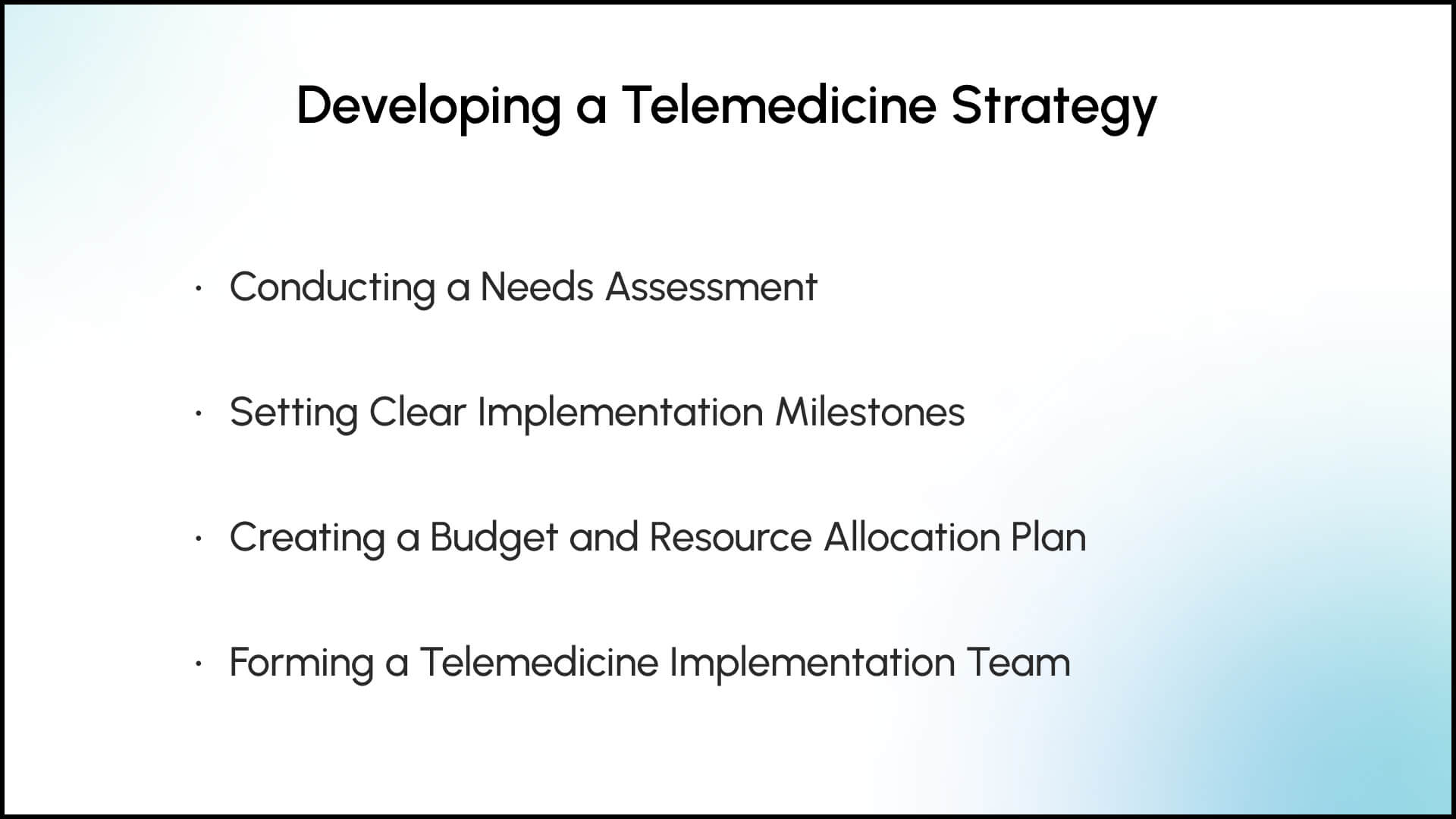
As healthcare providers begin implementing telemedicine, having a well-structured strategy is essential for success. Let’s explore the crucial steps in developing a comprehensive telemedicine strategy.
Before laying the foundation for a telemedicine program, it is essential to conduct a thorough needs assessment to understand the specific requirements and opportunities within the healthcare organization.
Patient Demographics: Analyze patient demographics to identify groups that can benefit the most from telemedicine services, such as elderly patients or those with limited mobility.
Chronic Disease Management: Assess the prevalence of chronic diseases within the patient population, as telemedicine can be instrumental in managing such conditions effectively.
Service Gaps: Identify areas where current healthcare services may not adequately meet patient needs, presenting opportunities for telemedicine intervention.
Patient Feedback: Gather patient feedback to understand their preferences for telemedicine and their willingness to adopt virtual healthcare services.
Defining clear milestones helps in tracking progress and ensuring that the telemedicine implementation stays on track.
Training and Onboarding: Establish a timeline for training healthcare professionals and staff on telemedicine protocols and platforms.
Pilot Programs: Set deadlines for conducting pilot telemedicine programs to gain insights and fine-tune the process before full-scale implementation.
Expansion Plans: Outline the roadmap for expanding telemedicine services to additional specialties or patient populations in the future.
Patient Adoption Targets: Define targets for the percentage of patients expected to utilize telemedicine services within a specific timeframe.
Developing a comprehensive telemedicine strategy necessitates careful financial planning and resource allocation.
Technology Investment: Allocate funds for acquiring telemedicine software, hardware, and any additional virtual diagnostic tools.
Training and Education: Factor in the costs associated with training healthcare professionals and staff on telemedicine best practices.
Staffing: Determine the additional staffing requirements for telemedicine services, such as telemedicine coordinators or virtual care specialists.
Time Commitment: Assess the time commitment of existing healthcare professionals to allocate sufficient time for virtual consultations.
Building a capable telemedicine implementation team is essential for ensuring a smooth and successful deployment.
Telemedicine Coordinator: Designate a coordinator to oversee the telemedicine program, manage resources, and handle communication with stakeholders.
IT Support: Include IT professionals with expertise in telemedicine technology to address technical issues and maintain system integrity.
Stakeholder Engagement: Involve key stakeholders, including administrators, physicians, and patient advocates, in the decision-making process to ensure comprehensive buy-in.
Regular Meetings: Schedule regular meetings to keep the implementation team updated on progress and address any challenges that arise.

Selecting the appropriate telemedicine technology and reliable vendors is critical to the successful implementation of a telemedicine program. Here we will explore the key considerations and steps involved in making the right choices for your healthcare organization.
Telemedicine software and platforms serve as the backbone of virtual care delivery. Careful evaluation of these technologies is essential to ensure seamless and secure telemedicine consultations.
Look for platforms that offer an intuitive user interface, facilitating easy navigation for both healthcare professionals and patients.
Assess the availability of essential features such as video conferencing, chat functionality, and secure file sharing during consultations.
Choose telemedicine software that seamlessly integrates with your existing EHR system, ensuring that patient data is readily accessible during virtual visits.
Evaluate the compatibility with your current EHR vendor or any potential adjustments required for smooth data flow.
Prioritize security features, including end-to-end encryption and secure data storage, to safeguard patient information during virtual consultations.
Ensure that the telemedicine software complies with relevant privacy regulations, such as the Health Insurance Portability and Accountability Act (HIPAA).
Equipping healthcare professionals and patients with the appropriate hardware is crucial for delivering high-quality telemedicine services.
Ensure that healthcare providers have access to high-quality webcams and microphones to facilitate clear communication during virtual consultations.
Encourage patients to use devices with a reliable internet connection and built-in cameras for seamless telemedicine visits.
Evaluate the need for remote monitoring devices, such as blood pressure monitors or glucose meters, to support virtual care for patients with chronic conditions.
Select devices that are user-friendly and can be easily integrated with the telemedicine platform for data sharing.
Partnering with reputable telemedicine vendors can significantly impact the success of your telemedicine program.
Research the vendor’s track record and experience in providing telemedicine solutions to healthcare organizations.
Read customer reviews and testimonials to gauge the vendor’s reputation and client satisfaction levels.
Inquire about the vendor’s technical support offerings, including response times for issue resolution and availability of 24/7 support.
Ensure that the vendor provides comprehensive training for healthcare professionals and staff on using their telemedicine platform effectively.
Consider the scalability of the telemedicine solution to accommodate potential growth in patient demand and service expansion.
Choose vendors that stay up-to-date with technological advancements and can adapt their offerings to meet evolving healthcare needs.
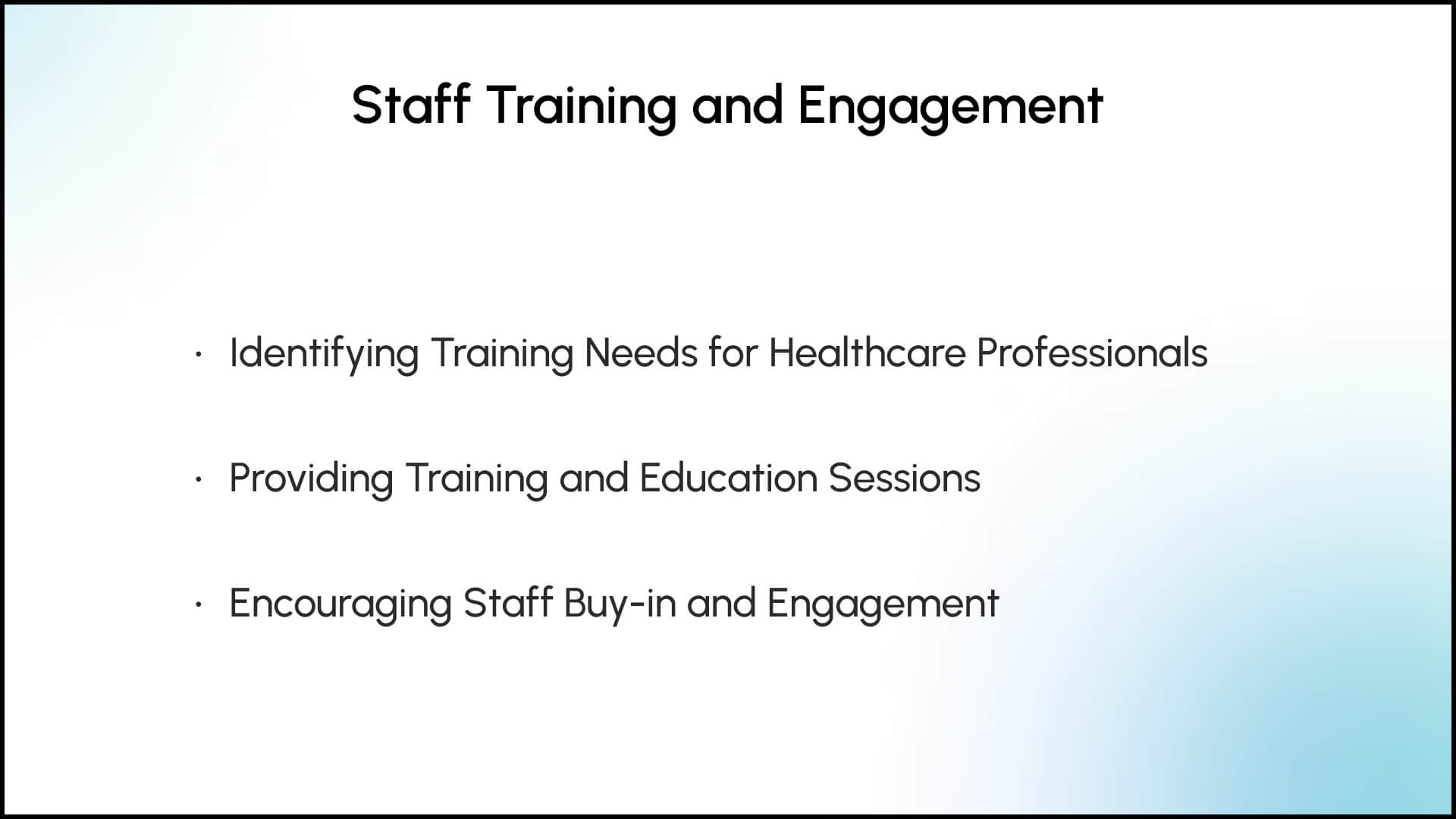
Making sure the staff is well-trained and engaged is super important when it comes to smoothly integrating telemedicine into the healthcare workflow. So, let’s check out the essential steps to get healthcare professionals all set to provide exceptional virtual care and ensure they are actively involved in the telemedicine implementation process.
Understanding the specific training needs of healthcare professionals is fundamental to tailoring a comprehensive telemedicine training program.
Evaluate the existing digital literacy level of healthcare professionals to determine the extent of training required.
Identify areas where additional support may be needed, such as using telemedicine platforms and conducting virtual consultations.
Provide specialized training based on the roles and responsibilities of healthcare professionals within the telemedicine program.
Offer in-depth training for specialists who conduct virtual consultations in specific medical fields.
Conducting structured training and education sessions ensures that healthcare professionals are proficient in telemedicine operations and best practices.
Conduct hands-on training sessions to familiarize healthcare professionals with the telemedicine software and platform.
Provide guidance on scheduling virtual appointments, conducting video consultations, and managing patient data securely.
Emphasize telemedicine etiquette, including effective communication and active listening during virtual consultations.
Educate healthcare professionals on providing compassionate and empathetic care in a virtual setting.
Engaging healthcare professionals and gaining their enthusiastic support are essential for the successful adoption of telemedicine.
Create an open forum for healthcare professionals to voice their concerns and address any apprehensions about telemedicine.
Provide evidence-based information and case studies that highlight the benefits of telemedicine.
Emphasize the positive impact of telemedicine on patient outcomes and healthcare delivery.
Celebrate success stories of colleagues who have effectively utilized telemedicine to enhance patient care.
Recognize and reward healthcare professionals who actively participate in telemedicine implementation and demonstrate exceptional virtual care skills.
Offer incentives and acknowledgments to boost staff motivation and commitment.
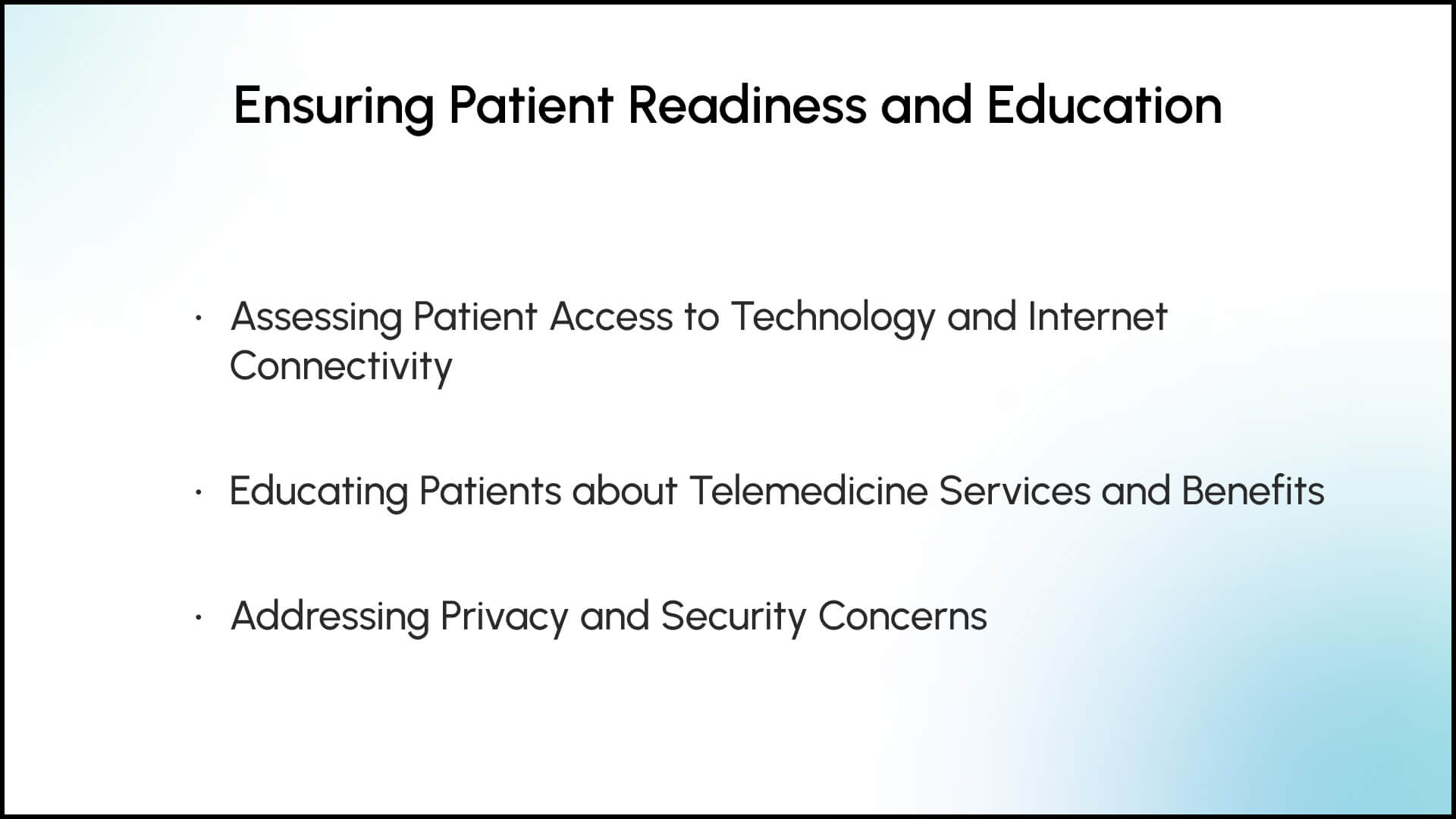
Ensuring that patients are well-prepared and informed about telemedicine services is crucial for a successful implementation. Let’s explore the steps to assess patient readiness and educate them about the benefits and process of virtual healthcare.
Before incorporating telemedicine into patient care, it is essential to evaluate patients’ access to the necessary technology and internet connectivity.
Determine whether patients have access to devices, such as smartphones, tablets, or computers, with a functioning camera and microphone for virtual consultations.
Identify potential barriers, such as limited access to technology among elderly patients or those from low-income communities.
Assess the reliability of patients’ internet connections to ensure uninterrupted video consultations and clear communication.
Explore alternative options for patients with limited internet access, such as audio-only consultations in cases where video may not be feasible.
Informing patients about telemedicine services and their benefits fosters trust and acceptance of virtual care.
Provide patients with a clear explanation of what telemedicine is and how it complements traditional in-person healthcare.
Highlight the convenience and accessibility of telemedicine, allowing patients to receive medical attention from the comfort of their homes.
Educate patients about the various benefits of telemedicine, such as reduced travel time and costs, shorter wait times for appointments, and improved access to specialists.
Emphasize how telemedicine can enhance chronic disease management and preventive care.
Walk patients through the step-by-step process of scheduling virtual appointments, joining video consultations, and accessing follow-up care.
Address common patient concerns, such as privacy and data security during virtual consultations.
Patient data privacy and security are paramount in telemedicine. Addressing patients’ privacy concerns helps build confidence in virtual healthcare services.
Explain the robust data protection measures in place, including secure data transmission and encrypted patient information.
Reassure patients that telemedicine platforms adhere to stringent privacy regulations, safeguarding their personal and medical data.
Obtain patient consent for telemedicine services, clearly outlining the scope of virtual care and the patient’s rights concerning their health information.
Provide patients with an opportunity to ask questions and seek clarifications before consenting to telemedicine consultations.
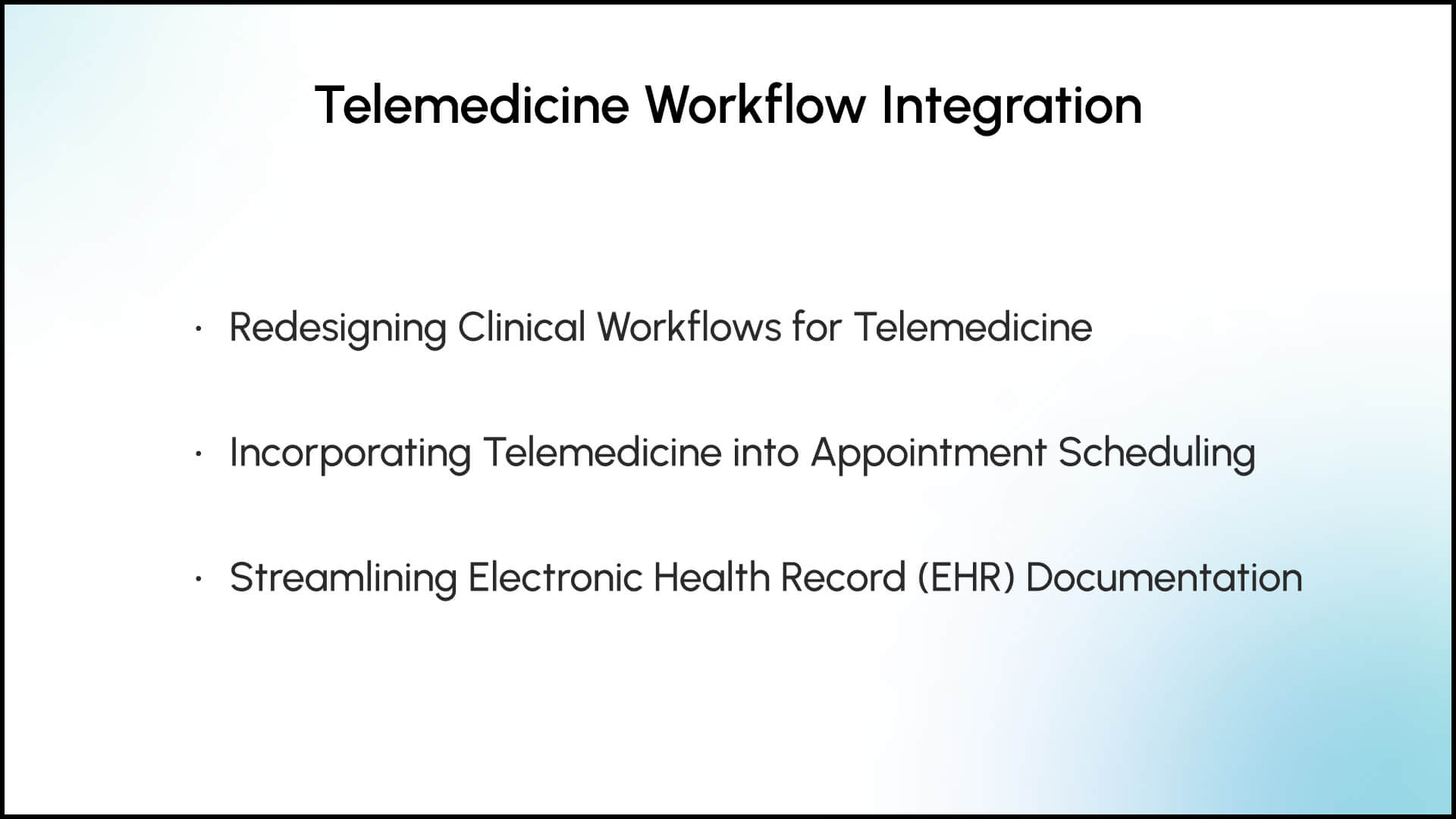
Integrating telemedicine seamlessly into existing healthcare workflows is a critical step in ensuring the smooth delivery of virtual care. Let’s explore the key considerations for redesigning clinical workflows, incorporating telemedicine into appointment scheduling, and streamlining electronic health record (EHR) documentation.
Adapting clinical workflows to accommodate telemedicine requires a strategic approach that maximizes efficiency and patient-centered care.
Conduct a thorough analysis of current clinical workflows to identify areas that can benefit from telemedicine integration.
Collaborate with healthcare professionals to develop new workflows that optimize virtual care delivery.
Clearly define the roles and responsibilities of healthcare professionals involved in telemedicine consultations, ensuring efficient patient triage and coordination.
Assign specific tasks, such as scheduling virtual appointments and following up with patients after consultations.
Efficient appointment scheduling is crucial for optimizing telemedicine services and providing timely care to patients.
Offer a range of appointment times for virtual consultations, accommodating the preferences and availability of patients and healthcare professionals.
Implement a user-friendly online scheduling system that allows patients to book virtual appointments easily.
Integrate telemedicine appointments into existing scheduling systems to maintain a unified approach to patient care.
Ensure that the telemedicine platform syncs seamlessly with other scheduling tools to prevent double-bookings and scheduling conflicts.
Effective EHR documentation is essential for maintaining comprehensive patient records and supporting continuity of care.
Customize EHR templates to capture essential telemedicine encounter information, including consultation notes, virtual diagnosis, and treatment plans.
Incorporate fields for documenting virtual visits and patient-reported outcomes.
Implement secure data transfer protocols to ensure that patient information from telemedicine consultations is seamlessly integrated into the EHR system.
Train healthcare professionals on proper data entry and documentation practices for virtual care encounters.
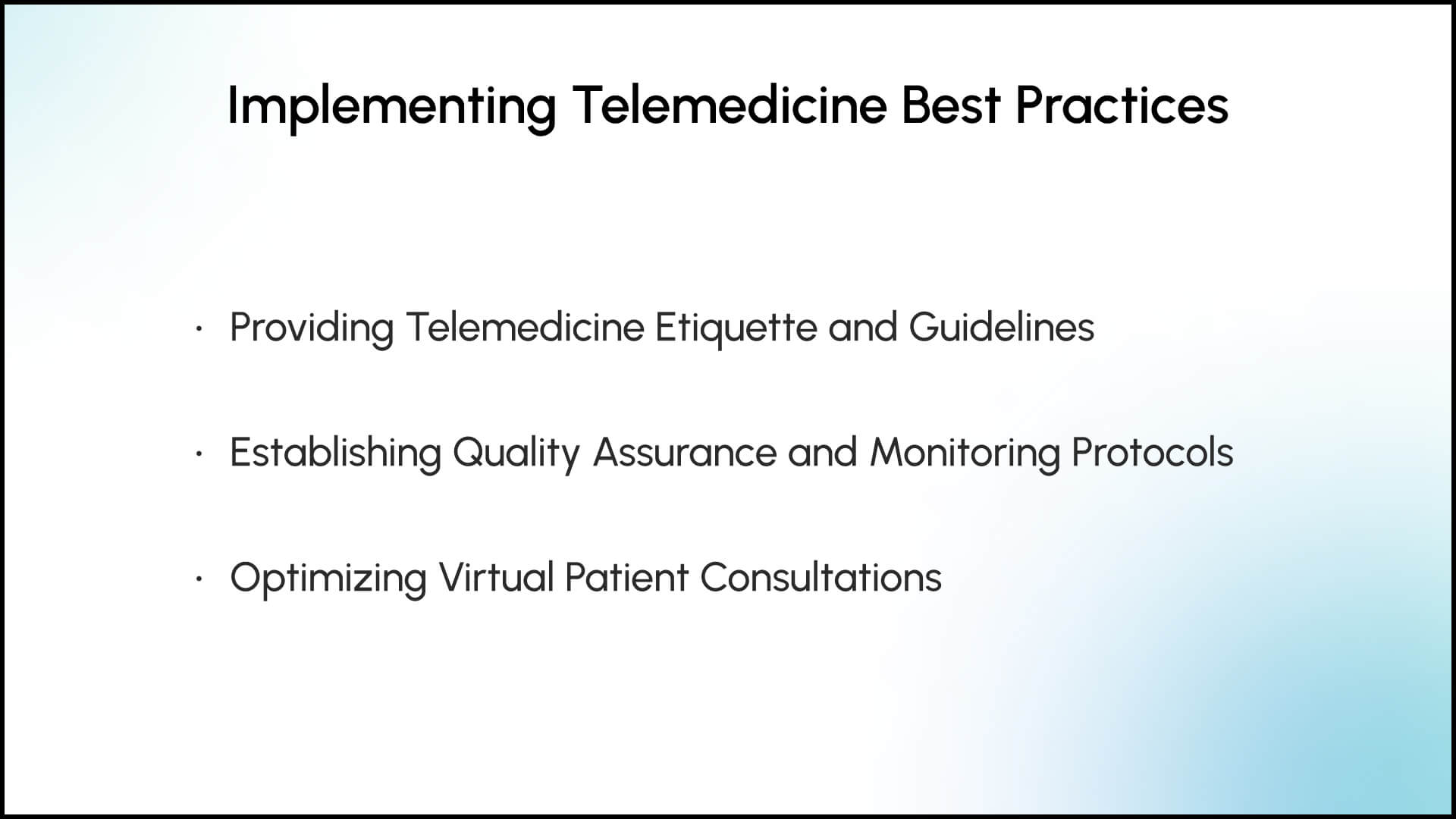
Implementing telemedicine best practices is essential for delivering high-quality virtual patient consultations and ensuring a seamless telemedicine experience. Let’s find out the key guidelines and protocols to optimize virtual patient consultations and establish a culture of excellence in telemedicine.
Establishing telemedicine etiquette and guidelines promotes professionalism and patient-centric care during virtual consultations.
Encourage healthcare professionals to greet patients warmly at the beginning of virtual consultations and explain the telemedicine process.
Emphasize active listening and clear communication to ensure patients feel heard and understood.
Advise healthcare professionals to conduct virtual consultations in a quiet and private environment, minimizing background distractions.
Encourage professionals to maintain eye contact with the camera during video consultations to enhance patient engagement.
Implementing quality assurance measures ensures that telemedicine services meet high standards of care.
Optimizing virtual patient consultations enhances patient engagement and the overall telemedicine experience.
Utilize visual aids and educational resources during virtual consultations to enhance patient understanding of medical conditions and treatment options.
Provide patients with reliable online resources and educational materials to support their healthcare decisions.
Implement a system for follow-up appointments and virtual check-ins to ensure continuity of care for patients receiving ongoing treatment.
Encourage healthcare professionals to review patient medical histories and previous telemedicine encounters to provide personalized care.

Implementing telemedicine comes with its unique set of challenges that healthcare organizations must address to ensure a successful transition to virtual care. Let’s explore common challenges that may arise during telemedicine implementation and strategies to overcome them.
Resistance to change is a common challenge when introducing telemedicine into healthcare practices.
Clearly communicate the benefits of telemedicine to healthcare professionals, emphasizing improved patient access to care and increased flexibility in delivering services.
Share success stories and case studies from other healthcare organizations that have successfully embraced telemedicine.
Offer comprehensive training and ongoing support to healthcare professionals to familiarize them with telemedicine platforms and workflows.
Encourage experienced telemedicine users among staff to mentor and support colleagues during the transition.
Technical issues can arise during telemedicine consultations, affecting the delivery of virtual care.
Establish a dedicated technical support team to promptly address any technical issues that healthcare professionals may encounter during telemedicine consultations.
Ensure that technical support resources are available 24/7 to minimize disruptions to patient care.
Prior to full implementation, conduct test runs of telemedicine consultations to identify and resolve any technical glitches or connectivity issues.
Encourage healthcare professionals to familiarize themselves with troubleshooting techniques.
Patient adoption of telemedicine services may face obstacles, particularly among those unfamiliar with virtual care.
Provide clear and accessible information to patients about telemedicine services, addressing any misconceptions or concerns they may have.
Offer tutorials or video guides to help patients navigate telemedicine platforms and understand the virtual care process.
Assess and address barriers to patient access, such as limited internet connectivity or lack of digital devices.
Explore alternative options, such as telephonic consultations, for patients with limited technological resources.
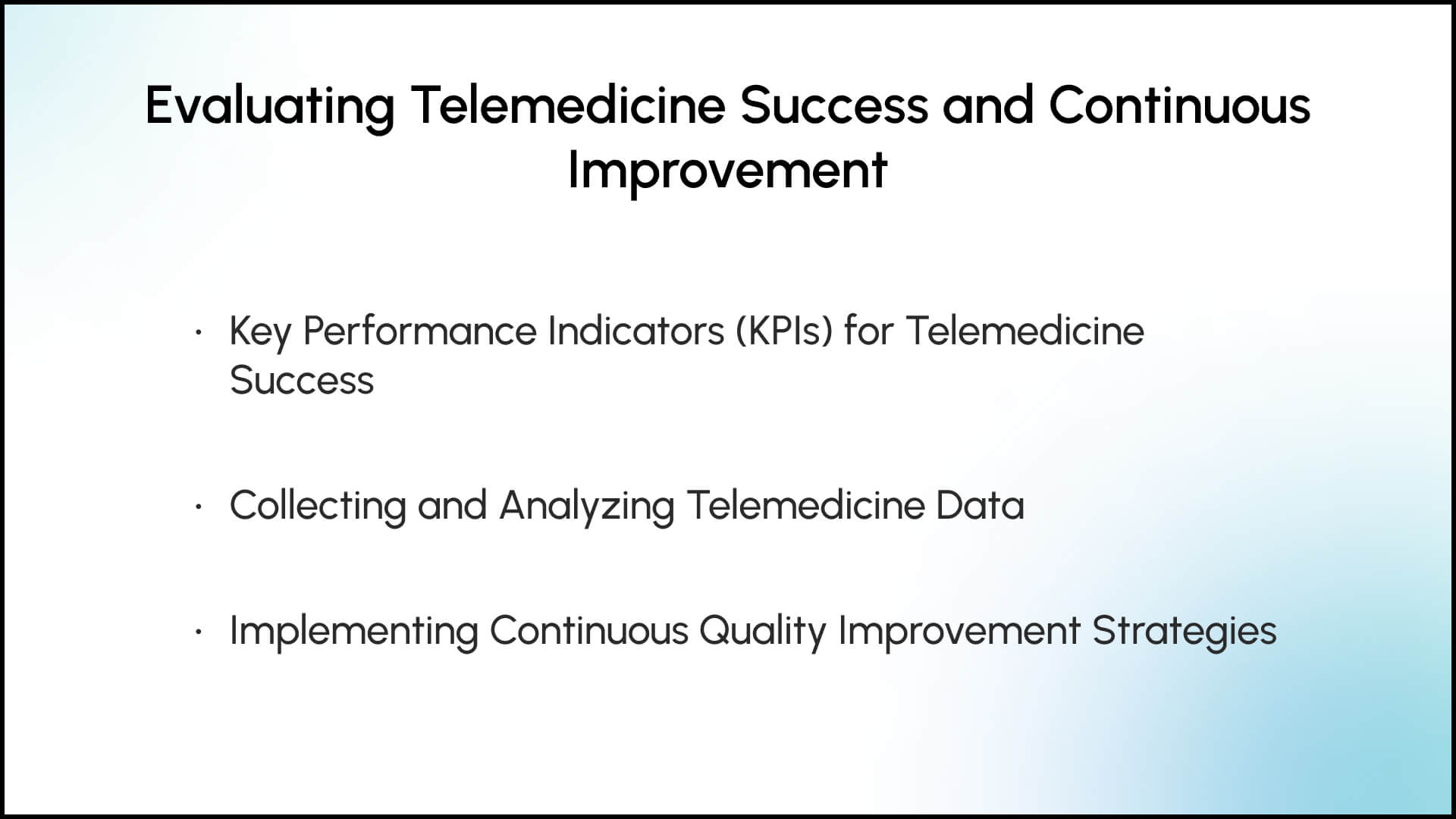
Measuring the success of telemedicine implementation and continuously improving virtual care services are integral to providing high-quality telemedicine experiences. Let’s check out the key performance indicators (KPIs) for telemedicine success, data collection and analysis, and strategies for ongoing quality improvement.
Identifying and monitoring KPIs helps assess the effectiveness of telemedicine services and their impact on patient care.
Measure patient satisfaction through post-consultation surveys, focusing on aspects such as convenience, accessibility, and overall experience.
Evaluate patient feedback to identify areas for improvement and address any concerns promptly.
Monitor appointment utilization rates for telemedicine consultations to gauge patient engagement with virtual care.
Track no-show rates to identify potential barriers to patient participation and optimize scheduling processes.
Data collection and analysis are essential for assessing the performance of telemedicine services and making informed decisions.
Measure the number of telemedicine consultations conducted over a specific period to gauge patient and provider adoption.
Track patient satisfaction scores to understand how well telemedicine meets patient needs.
Monitor changes in patient health outcomes following telemedicine consultations.
Assess the impact of telemedicine on healthcare outcomes, such as readmission rates and treatment adherence.
Evaluate cost savings achieved through telemedicine, including reduced hospitalization rates and travel expenses for patients.
Analyze the time saved by healthcare providers through virtual consultations.
Continuous quality improvement is an iterative process that allows healthcare organizations to refine telemedicine services continually.
Conduct root cause analyses to identify underlying reasons for any issues that arise during telemedicine consultations.
Use the findings to implement targeted improvements.
Provide ongoing training and professional development opportunities for healthcare professionals involved in telemedicine.
Encourage staff to share best practices and innovative ideas.
Foster collaboration among different healthcare organizations to share knowledge and experiences in telemedicine implementation.
Participate in telemedicine conferences and workshops to stay updated on industry trends.
Telemedicine implementation requires a well-structured approach, strategic planning, and continuous evaluation. By following this step-by-step roadmap, healthcare organizations can utilize telemedicine to offer accessible, high-quality care to patients, no matter where they are located.
Embracing telemedicine is more than just a choice; it’s a commitment to making healthcare more accessible and improving patient outcomes in the digital age.
As we set out on this exciting journey, integrating telemedicine into healthcare practices brings us closer to a more connected, patient-centric, and innovative future for healthcare delivery. Together, we can reshape the healthcare landscape and create a healthier world through the power of telemedicine.
Our white label software, equipped with integrated features like provider management, appointment booking, and secure video consultations, makes telehealth seamless. Let go of tech concerns – we’ve got you covered. With a versatile platform accessible on web, iOS, and Android, Confy ensures universal connectivity.
Flexible pricing and no revenue commitments empower you to step into telemedicine confidently.
Partner with Confy for expert guidance and elevate your practice to the forefront of modern healthcare. Contact us today!

December 9 2023
8 min read

December 4 2023
8 min read

November 30 2023
8 min read

November 22 2023
8 min read